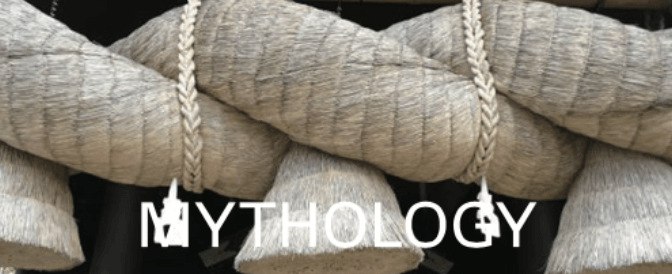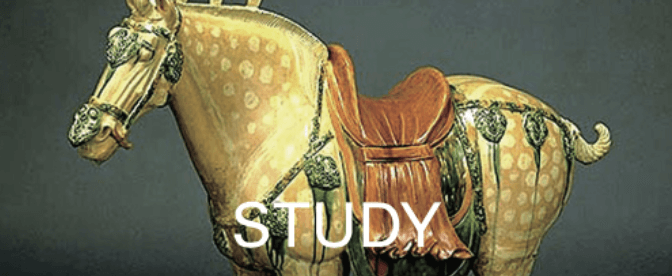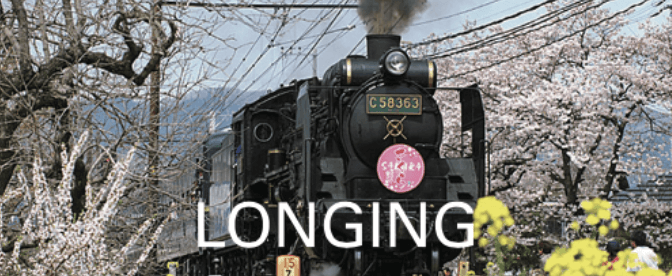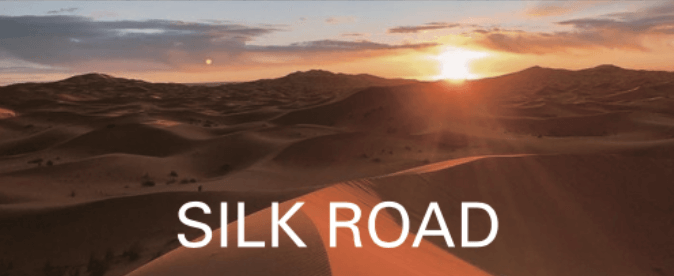
The museum was opened in 1992, upon the death of Irie Taikichi (1905 – 1992), a Japanese photographer. There is Taikichi’s “Harumeku Nigatsudo Urasando, at the beginning of spring, the rear approach to the Nigatsudo Hall of Todaiji Temple.” Irie shot this location many times for revised versions of the best selling book “Koji Junrei”, A Pilgrimage to an Ancient Temple by Watsuji Tetsuro (1889 – 1960), a Japanese moral philosopher and cultural historian.
Tetsuro wrote the book in his twenties, after he saw the reproduction of Ajanta Cave India at his friend’s house. Watsuji visited Toshodaiji Temple, Yakushiji Temple, Horyuji Temple, and Chuguji Temple in Nara, and other temples near Nara. He wrote down their impressions with passion about the history of the establishment of early Buddhist art from the eastern influence of Greek culture.
And Irie said, “The rusty sight of this approach gives you a feeling of the ancient capital of Nara.” Irie shot the scenery, Buddhist statues, and events of Nara Yamatoji (the roads to Nara). His starting point was the standing statue of Shitenno, the Four Guardian Kings, enshrined at Hokke-do Hall of Todaiji Temple, which was rumored to have been confiscated by the United States after the World War II.
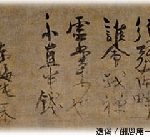
Emperor Go-Komatsu (1377 – 1433) was a master of calligraphy. Ikkyu (1394 – 1481): a Zen Buddhist monk and poet, who had a major influence on the infusion of Japanese art and literature with Zen thought, was also a master of calligraphy, in the Muromachi Period (1366 – 1573).
He is said to have been an illegitimate child of Emperor Go-Komatsu. Ikkyu was a teacher of Murata Juko (1423 – 1502), a monk and the founder of the Japanese tea ceremony, who founded Wabi, a tea ceremony of refined beauty and simplicity.
He remained the Yuige, a poem for disciples, made by a high priest prior to one’s death, which mentioned “Ikkyu’s zen, No one can understand it if Ikkyu died.” His understanding was a refined style that overlapped Chinese poetic unconventionality and an elegance beyond worldliness, like the court.
The beauty sensibility of Ikkyu has transcended the ages. And this temple possesses the Yuige of Ikkyu.

This museum possesses Totetsumon-hoyu, a Chinese ritual bronze vessel, designed with the motif of Taotie, a Monster in Chinese mythology. This work was in ancient China, at the time of the Yin Dynasty, prior to 11 BC. Totetsumon, with the design of Taotie, created characters to keep away disasters and victims.
Dr. Shirakawa Shizuka (1910-2006), an authority of Chinese Characters research, gave lectures on ancient Chinese culture for many years, at this museum. This museum’s collection spans centuries; from ancient Chinese bronze to Ming Dynasty (1368-1644) pottery, Japanese Buddhist crafts and scrolls from the Asuka period (592-710) to the Heian period (794-1185), and Japanese picture scrolls from the Edo period (1603-1868).
This collection provides an outstanding education in Oriental studies to know JAPAN.
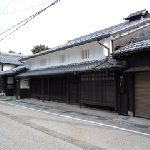
Kashiwabara post town is the sixtieth of the Sixty-nine stops on the Nakasendo, the route connecting Kyoto and Edo in the Edo period, which is 21 ri, (a Japanese unit of distance) or 90 km to Kyoto and was the border of the gold standard in Edo and the silver standard in Kyoto.
Utagawa Hiroshige (1797 – 1858) was an artist of Japanese ukiyo-e, who painted city pleasure and travel with woodblock prints and painting. He painted a long established store, Ibukido, at this post town, in the series of the Nakasendo Ukiyoe, Japanese woodblock prints, at the end of the Edo period (1603 – 1868).
A well-known product was Ibuki mogusa, a moxa used for healing, which had a reputation as far as Edo. The townscape still conveys the taste of those days with pillars, rafters, beams, etc., which are painted using Bengala, red iron oxide.
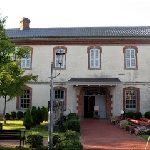
In this square, the first Nagahama Station, built in 1882 as the starting station of the Hokuriku Line, is preserved. It is the oldest existing station building in Japan. The station building is a Western-style building with two-stories, designed by an English engineer.
The features of the station building remain unchanged, such as the stationmaster’s room and the waiting room. Nagahama Tetsudo Bunkakan, the Railway Culture Museum, exhibits historical materials about the transportation at Biwa Lake, and Hokuriku Line Electrification Memorial Hall displays a D51 style of steam locomotive.
You can see the transition of the railroad from modern to the present times!
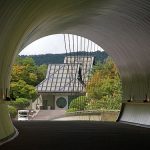
The museum is located near to the historical site of Shigaraki Royal Palace, built by Emperor Shomu. Shomu embraced the idea of having the country learn the culture of the Silk Road and the institution from the Tang Dynasty (618 – 907). Gandhara is where ethnic groups of the Orient, India, and the western region of China exchanged goods and services.
A 2.5m tall Buddha statue is in this museum’s possession. It is one of the largest figures of Gandhara Art. The downcast eyes of this statue tell the fact that this statue used to be worshiped widely on the high base. The downcast eyes overlapped also representative of an ideal of the Tenpyo Period (729-749) under Emperor Shoumu (701 – 756).
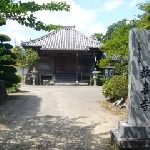
Aridagawa Town is the birthplace of Myoe Shonin (1173 – 1232), a Japanese Monk, and the originator of the restoration of the Kegon Sect, who founded Kosanji Temple. There are Kishuu Hasho Iseki, 8 sites associated with Myoe Shonin in Kii Province, Wakayama, including the ancient Kangiji Temple, founded by Eshin Sozu Genshin (942 – 1017), the 18th head of the Enryakuji Temple.
Genshin compiled Ojoyoshu, “Essentials of Birth in the Pure Land”, and the Hoshio Site, where Myoe Shonin had the oracle of Kasuga Myojin, the deity of Kasuga Shrine, Nara.
The Myoe Shonin records the dream he had. He loved the moon and made poems about the moon. In addition, his maternal family, the Yuasa clan, was connected to the Kamakura Shogunate and he interacted with Unkei (1150 – 1223), a Japanese sculptor of the Kei school, and his son. They deepened the Buddhist faith in Arida Wakayama.

The Kunitomo Tetsupo gun was said to surpass the imported Hinawajyu matchlock gun in quality. That technique was passed on to the astronomical telescope made by Kunitomo Ikkansai (1778 – 1840), a Japanese gun manufacturer at the end of the Edo period (1603 – 1868).
This center in Nagahama City introduces Ikkansai of Thomas Edison in Asia. He created a reflecting telescope, by himself, and made the surface of the moon diagram with his own reflecting telescope. He also recorded a highly accurate sunspot observation diagram. The four telescopes are preserved and they still look sharp.
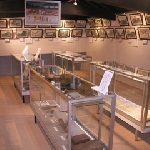
Ibuki mogusa, a moxa used for healing, was a well-known product of Ibukido at Kashiwabara post town on the Nakasendo Road. It was sold all over the city in the Edo period (1603 – 1868) and had a reputation as far as Edo.
This museum’s building was built in 1918 as the residence of Matsuura Kyuichiro, a member of the family that founded Ibukido, a long established store, which conveys the prosperity of the sixtieth post town on the Nakasendo, the route connecting Kyoto and Edo in the Edo period.
You can also enjoy Kashiwara Gozen, a meal, at its Japanese style salon (with a reservation) which evokes the memory of Hatago, an inn during the Edo period.

This museum opened after the Osaka World Expo in 1970. It exhibits and introduces the cultures of the world’s peoples, centering on statues of gods, masks and daily necessities of the world gathered at the World Expo Theme Pavilions. — The diversity and commonality of human culture. At the West Asia gallery of this museum, camel tools and equipment used by Arab Bedouins are exhibited.
In Western Asia, also known as the Middle East, the people of nomadic livelihoods had crossed the desert. They called North Africa “the land of the sunset,” with which they had close relations, and they called the land they live as “the land of the rising sun”.
– In 607, the Prince Shotoku (574 – 622) sent an envoy ship to the Sui Dynasty (581 – 618) with a sovereign letter. In the sovereign letter, it was described that the Emperor of “the land of the rising sun” (in Japan) sent it to the Emperor of “the land of sunset” (in China).
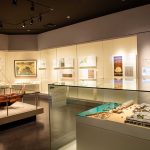
This museum is located in the former foreign settlement. It is a refurbished and extended building that was the Yokohama Specie Bank Kobe Branch. It was designed with Neo-Classicism architecture, with lined, Doric columns.
This museum boasts one of the finest quality and quantity collections, related to east-west exchange, in Japan. The collection includes Nanban Art, a Japanese Art in the 16th -17th centuries influenced by Portugal and Spain, Komo Art, a Japanese Art in the 17th -19th centuries, influenced by the Netherlands, old maps, and glass materials, etc.
The exhibition introduces the aspect of cultural exchange between Japan and foreign countries, focusing on Kobe. The east-west exchange has been from ancient times which is shown through the National Treasure Dotaku, bronze bells and Bronze dagger-axe of Sakuragaoka, Kobe.
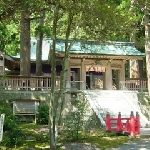
This shrine is located on the northern tip of Hamochi plain on Sado Island and is surrounded by a rich and prosperous forest embraced by a calm mountain. This shrine’s dignity shows the prime shrine as Ichinomiya in Sado Island. It enshrines the God Isotakeru, as Guardian of traffic safety on land and sea, and as God of afforestation. When the Jomon period(16,000-3000 years ago) began, the sea level rose, and the Tsushima warm current flowed into the Sea of Japan. At that time, people came from western Japan-Kyushu Island, Izumo Province Shimane, and middle-northern Japan-Noto Peninsula, to Sado. They made rich forests, and rich myths were handed down here.
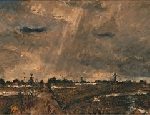
The Niigata Prefectural Museum of Modern Art possesses works of the Barbizon school, Navi school, and German expressionism. The museum also features domestic works since the Meiji period (1868 – 1912) that trace the modern times, and many works of the artists from Niigata Prefecture, such as the master of Japanese painting, Tsuchida Bakusen (1887 – 1936), Kobayashi Kokei (1883 – 1957), and Yokoyama Misao (1920 – 1973). “Zansetsu, the remaining snow
– Sato Tetsuzo”. Sato Tetsuzo (1910 – 1954) won the highest prize in succession at Kokuten (Kokugakai), Japanese artists association, but continued his life’s work out of power. He symbolically portrayed the local climate and people, and also worked hard to teach children painting and local cultural activities.

“The Symbol of Made In Japan,Toyota Motors!” – The main exhibits at the Toyota Automobile Museum are about 140 vehicles from around the world. This museum presents the history of the automobile in a more approachable manner, and shows how the interaction between Japanese and foreign carmakers stimulated and accelerated the evolution of the auto industry throughout the world.
Under the theme of “Mobility and culture- Mobility fosters culture and culture encourages mobility,” the Car Cultural Materials Room exhibits approximately 4,000 cultural materials related to automobiles, such as posters, car toys, and car mascots.

Nagaoka is a heavy snowfall area where the Shinanogawa River flows through to the Japan Sea. Nagaoka was rebuilt twice from catastrophic damages, first from the Boshin War (1868-1869), the Japanese civil war between Imperial and shogunate forces, and then during the 2nd World War.
Kawai Tsugunosuke (1827 – 1868), a retainer who served the Makino clan of Nagaoka and a senior military commander of Nagaoka forces in the Boshin War of 1868 – 1869, said “I want to learn practical science”. At 33 years of age, he wandered to the west countries in Japan. He wrote Chiritsubo, travel writing, which still remains.
This museum introduces the philosophy and spirit of Tsugunosuke, who was a commander of the Nagaoka clan, and fought with the government army in the Boshin War, although he understood well the modernization, and strove for it.

Himi seashore has a beautiful, varied coast, from Matsudae Nagawaha in the south, with its sandy seashore dotted with pine trees, to Nadaura seashore in the north, and its Araiso, rocky shore. Tateyama Mountain Range stands like a folding screen out at the sea of Himi. There is a rare view of the mountains over the sea.
Through the Himi-oki Cruise Tour, you can enjoy the mysterious scenery of Japan’s Top 100 sunrise viewing sites, with the long-worshipped Tateyama Mountain Range in the background. The mysterious scenery includes the site of Aojo Castle, with its spectacular rock surface and large permanent shore net.
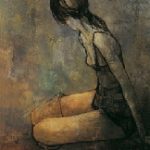
This museum possesses over 700 works of oil paint, watercolors, and drawings by the masters of the painting circle in France. Jan Jansen (1920 – 2013), a French-Armenian painter, introduces the collection. Jansen is highly regarded around the world for his outstanding drawing technique.
He was born as an Armenian in the early 20th century, but during his childhood, he migrated to France through Greece. And he became a writer who can draw the true character of human beings in their harsh destiny. His works are always full of warm eyes.
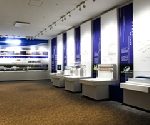
“The Latest Made In Japan: SCMAGLEV !” -Visitors know, via archival documents and film, the stories of the Tokaido Shinkansen, now passing through Japan’s principal metropolitan areas of Tokyo, Nagoya, and Osaka. Those stories tell you how the route was selected and the history of its test runs. And you can experience the 500 km/h speed of the SCMAGLEV.
This museum exhibits “advanced high-speed railway technology” with exhibitions from conventional lines to superconducting linear systems centering on the Tokaido Shinkansen (the Tokaido bullet train). It provides an opportunity to study the impact of railways on society from an economic and cultural perspective.
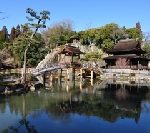
This temple was founded by Musou Kokushi (1275 – 1351), a Rinzai Zen Buddhist monk and Kokushi, a national Zen teacher, who built Tenryuji Temple in the first rank of Kyoto Gozan, the five great Rinzai temples of Kyoto. He accomplished this by suggesting the dispatch of Tenryuji bune, trading vessels, to the Yuan Dynasty (1279 – 1368), in order to raise funds to build Trenryuji Temple in the period of the Northern and Southern Courts (1336 – 1392), for the Ashikaga Shogunate.
The party of Soseki met the incarnation of Sacred Kannon, the Buddhist Goddess of Mercy, riding a white horse at the foot of Mt. Nagase, in 1313 and the statue of the Sacred Kannon was left behind. Soseki built Kannon-do, the temple deciated to Kannon, the Buddhist Goddess of Mercy.
The garden in front of the Kannon-do, has the Garyu Ike pond and the Musaibashi bridge, an arched bridge. The scenery of the garden overlaps with the beauty of Karamono Shogon, maestoso things imported from China.
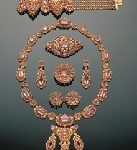
The museum possesses collections of Kanou Hogai (1822-1888,), who created the earliest modern Japanese paintings, and exhibits works related to the history of the region.
Okajima Tatsugoro, born in Ono Fukui during the Meiji period (1868 – 1912) , studied casting at the Tokyo School of Fine Art and operated an art trading business in New York. As a metalwork artist, he had an aesthetic eye backed by deep knowledge and experience. The Okajima Collection, consisting of gold-copper Buddha, sword ornament, smoking utensils, currency etc. is a must-see.
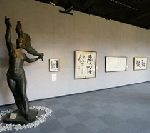
This museum aims to become a distinctive museum in a small village, and has 2600 pieces in its collection. Totenko, bronze sculpture, by Matsumura Sotojiro (1901 – 1990), is a representative work of this museum.-“Let’s sound our voice in the morning sun, like Totenko.” : Totenko means the voice of a chicken crying in the dawn. When Sotojiro was 33 years old, in 1933, he went to Paris to study under Antoine Bourdelle (1861 – 1929), who was the great master sculptor. After returning to Japan, he continued to say that the spirit of sculpture is the structure. Shinshu Shinmachi Town, Nagano City, where this museum is located, is at the northern part of the Fossa Magna, the 6,000 meter deep land fissure created at the border of the Eurasia and the North American continental plates, 20 Million years ago. It was at the Japanese Sea floor, 5 ‒ 4 Million years ago and sea floor fossils were excavated.

The Sakai family in Matsumoto was a wholesaler of paper during the Edo period (1603 – 1868). They loved calligraphy and antiques. The Sakai family actually interacted with Katsushika Hokusai (1760 – 1849) and Utagawa Hiroshige (1797 – 1858), Japanese artists of Ukiyo-e painting and woodblock printing. Both drew city pleasures and travel using woodblock prints and painting.
You can see Japan’s proud Ukiyo-e, including “Fugaku Sanjurokei, Thirty-six Views of Mt. Fuji” a woodblock printing series produced during 1830 – 1832 by Katsushika Hokusai, and “Tokaido Gojusan Tsugi, Fifty-three Stations on the Tokaido, the route connecting Kyoto and Edo Tokyo in the Edo period,” a woodblock printing series by Utagawa Hiroshige.
There are about 100,000 works in the Ukiyo-e collection at this museum, collected over the five generations of the Sakai family, spanning 200 years. Matsumoto is located at the top of the Japan archipelago, where, through Union-e, you can experience the days when people looked out at Japan.
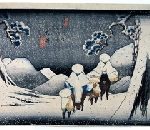
This museum possesses 121 pieces of Hatsuri, first print and Gosuri, second print of Ukiyoe, Japanese woodblock prints, of Nakasendo Rokujukyu Tsugi. The 69 post towns of the Nakasendo, the main road inland between Edo, Tokyo and Kyoto in the Edo period (1603 – 1868), which is the Soroimono, series of the same theme.
Magomejuku, a post town, is a former Yamaguchi Village in Nagano Prefecture, and currently in Nakatsugawa City, Gifu Prefecture. Magomejuku is the southernmost post town of Kiso Juichishuku, 11 post towns in the Kiso district on Nakasendo. It was the hometown of Shimazaki Toson (1872 – 1943), a Japanese author, who wrote” Before the Dawn” as the model of Magomejuku.
The entire post town is formed along the ridge of the mountain, and there are many steep slopes. But the view of Mt. Enasan is as beautiful as the Ukiyoe by Utagawa Hiroshige (1797 – 1858), artist of Japanese ukiyo-e, paintings that depicted city pleasure and travel, using woodblock prints and painting.

The Nagaragawa River is one of Japan’s three major clear streams, and originates from Mt. Dainichigatake in Gujo City. The Nagaragawa Railway runs along the Nagara River in Okumino, which is full of rustic flavor.
The train runs the Pass between the Yamada Station and the Tokunaga Station, where there is the shrine of Mt. Hakusan and the Village of Kokin denju, the initiation to the interpretation of Kokin Waka shu, Imperial anthology from the 10th century.
You can meet the richness of Japan that has been handed down, such as the river that inhabits the red-spotted masu trout, the rural landscape on the bank, the refreshing shrine forest, and the cherry-colored haze on the plain at the foot of Shinowakijo Castle.
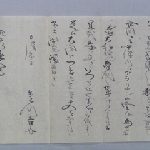
Nakatsugawa post town of Nakasendo Rokujyukyu Tsugi, Sixty-nine stops on the Nakasendo, the route connecting Kyoto and Edo in the Edo period, was a Shogun demesne, which was a midpoint between Edo and Kyoto. Fusetsu dome, a memo collection of hearsay, was left behind at this important post town.
This historical material mentioned the appearance of the procession of Princess Kazu (1846 – 1877), the wife of Tokugawa Iemochi (1846 – 1866), the 14th Shogun of Tokugawa Shogunate, in the Kazunomiya Koka, the marriage of Princess and Shogun, as an integration of the court and the shogunate. It addresses the classified action of Sakamoto Ryoma (1836 – 1867), a low ranking samurai from Tosa Domain, who influenced the Meiji Restoration, the establishment of the Empire of Japan, after Saccho Meiyaku, the Confederacy of the Satsuma Domain and the Choshu Domain.
It also contains stories of the Arrival of the Matthew C. Perry (1794 – 1858), a Commodore of the United Sates Navy, who played a leading role in the opening of Japan. It mentions a volcanic eruption, an earthquake, and the conflict between the Shogunate and the Choshu Domain.
Fusetsu dome shows that the merchants to visit this post town knew well those political situations under the mess in the End of the Edo period (1603 – 1868).
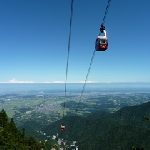
The Mie river drawn at Yokaichi Miegawa, from the Ukiyo-e series “Fifty-three Stations of the Tokaido (the route connecting Kyoto and Edo Tokyo in the Edo period)” was the Mitaki River. The river was originated from Suzuka Montains, where ancient granite appears as huge and uniquely-shaped rocks. It was named after three waterfalls near the headstream.
One of them, Aodaki, the blue waterfall, has a 50 meter drop, and the water flows vigorously on a huge granite rock surface 10 m wide. And it glows blue, as the name implies.
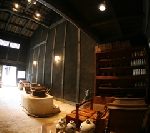
Seki post town, was the forty-seventh of the Fifty-three stops on the Tokaido, the route connecting Kyoto and Edo Tokyo in the Edo period. It was the post town that crossed the Isebetsu Kaido, a route to Ise Province Mie, from east Oiwake, forked road, and to Yamato Kaido, a route to Nara, from west Oiwake. It was a vibrant post town.
Chokan-tei in Hyakurokuri-tei, park is located in Hyakurokuri, 106 ri, (a Japanese unit of distance) or 416.2km from Edo and in the center of this post town. It has a panoramic view of Seki post town’s houses.
O-Hatago, a large inn, Tamaya, was restored as valuable Hatago architecture from the Edo period, and was transformed to the historical museum, to exhibit Ukiyoe, Japanese woodblock prints, by Utagawa Hiroshige (1797 – 1858), artist of Japanese ukiyo-e, who depicted the city pleasure and travel by woodblock prints and painting.
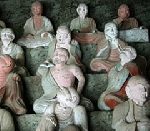
The colored statues of 500 Rakan, disciples of the Buddha, are memorial statues for people who passed away in the Iwami Silver Mine during the Edo period (1603 – 1868). Those and three arched bridges were made for a span of 25 years by Tsubouchi Heihichi (1767 – 1798), a Japanese mason at Fukumitsu, Yunotsucho, Shimane, and his son with his disciples.
Rakan is in between the Buddha and the people. Those arched bridges were made of local Fukumitsu-ishi, tuff, which is a pale blue-green, and had been deposited on the sea floor for ages (15 – 16 millions years ago) . Fukumitsu-ishi supports and accompanies the eternal journey of the soul.

This Museum of Literature is located in the northwest of Fukuyamajo Castle, and it presents and introduces literary people related to Fukuyama City. The museum also collects and researches various materials, and exhibits literature from writers in the Bingo region of Hrioshima, aiming to develop the culture in this region. Ibuse Masuji (1898 – 1993) is a Japanese novelist born in Kamo-cho, Fukuyama city.
He wrote a famous novel, Sanshouo – salamander. The story of a salamander who developed a big head and could not get out of the grotto. Ibuse studied locally at the Kamo Elementary School, which used to breed two Sanshouo,,,,,.
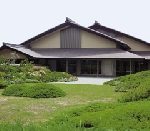
This museum also exhibits precious boyhood paintings, sketches, rough-sketches, and other late-life works of Hirayama Ikuo (1930 – 2009). Hirayama was bombed on August 6, 1945. After suffering from an aftereffect of an atomic bomb, he draws many works that hope for peace, including “Transmission of Buddhism”.
In search of the origin of Buddhism, he traveled to the Silk Road. That distance reached 350,000 km. Travel makes history and traveling makes people.

This museum specializes in the Orient, with about 5,000 items focused on the archaeological arts of West Asia from the ancient times to the early modern times. The Relief of Assyria, the Eagle-headed deity with wings from BC 9th century Iraq, is a part of the wall decoration at the Palace of Assyrian, which had unified the ancient Orient world for the first time.
The winged synthetic beast, Chimaira, is a prototype of Tenma, a flying horse, which had been revered from the Tumulus period (the 3rd– 7th century) to the Nara period (710 – 794) in Japan.
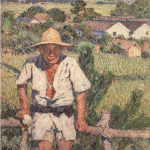
The museum was opened in 1953 to praise the virtues of Western painter Kojima Trajiro (1881 – 1929), who was born in NARIWA Town.
A farmer in Sakazu, (Kurashiki City), 1914, by Kojima Trajiro – It is his enthusiastic work that Trajiro tried to apply, in the Japanese context, the expression and the light technique learned in Belgium during his study abroad in 1914. For the chimney of the Obie Copper Mine, he painted directly on the canvas, without using a brush, to create a haziness above the surface.
The background was made up of delicate dots and lines, along with the person and the pine tree behind him. He used the original colors as they are, and drew a summer day when the sun shined brightly.
– After returning from Belgium, he married and lived in Sakazu, in 1913.The future was shining, too.
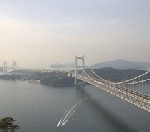
The waterway is now connected by three suspension bridges and two cable-stayed bridges, which were used to carry rice from Sanuki Provice, to Kurashiki, the Shogun demesne, in the Edo period (1603 – 1868). Those long bridges have a two-layer structure.
The upper part is the Seto-Chuo Expressway, with 4 car-lines and the lower part is the JR train Honshibesan Line. Kitabisansetohashi Bridge is a suspension bridge, which has a bridge girder 65 m above the sea level and easily passes the world’s largest large-scale vessels of 500,000 ton class.
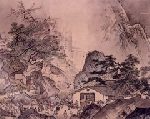
This museum possesses and exhibits about 20,000 pieces of art and crafts and historical materials of the Mouri family, who was the feudal lord of Choshu Domain.
The greatest treasure of this museum is Shikisansuizu, Landscape of the Four Seasons, (Sansui Chokan, Long Landscape Scroll) by Sesshu Toyo (1420 – 1506), a Zen monk and the master ink painter in Japan. This Chokan was drawn with a grand composition, 16m in length, depicting a long journey.
It uses the Chinese drawing style and the Japanese subtle changing of the landscape over the four seasons. Sesshu was born at Akahama Bichu Province Okayama and learned painting from Tensho Shubun, a Japanese Zen Buddhist monk and Painter in the Muromachi Period (1366 – 1573), and a director of the painting bureau, in the Ashikaga Shogunate, at Sokokuji Temple in Kyoto, since he was 13 years old.
He moved to Yamaguchi from Kyoto and started to use Sesshu, as his pseudonym. He went to China during the Song Dynasty (960 – 1279), to study painting.
After returning, he toured around various Provinces and returned to Yamaguchi. This Chokan was made just before Sesshu turned 70 years old, which overlaps with the longest journey of his life.
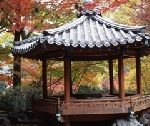
This park is in the site, where many temples gathered. Relocated from Korea. Rokkaku-tei was built by nobles in locations of great scenic beauty, as places for relaxation.
Dokuryu Shoeki (1596 – 1672) was a Zen monk of Obaku sect in China. He fled the war and came to Nagasaki in 1918 at the end of Ming Dynasty (1368 – 1644). And he naturalized to Japan. He greatly influenced the improvement and development of Iwakuni culture in various fields, such as medical science, arts and sciences, and philosophy. There is a monument to him in this park.
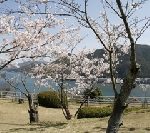
Ushimado, Setouchi City had been a port for awaiting a favorable tide and wind, since ancient times. The name of this place, Ushimado, was derived from Ushioni (a cow demon orally handed down in western Japan), that was thrown by Sumiyoshi Myojin, a guardian of safe sea travel, Waka (Japanese poem), and agriculture and fishing.
Okayama domaine hosted Chosen Tsushinshi, Envoys from Korea for Peace Building and Cultural Exchanges between Korea and Japan from the 17th to 19th century, here in the Edo period (1603 – 1868).
And the sunset in this town was selected as one of the top 100 sunsets in Japan. Kaikei, who was a sculptor of Buddha statues of the Kei school, during the Kamakura period (1185 – 1333), made the statue of Amida Buddha: the principal image of Buddha in Pure Land, as it was calculated so that the sunset would overlap.
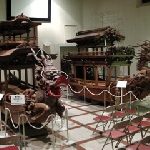
The museum, through historical materials, introduces Chosen Tsushinshi, Envoys from Korea for Peace Building and Cultural Exchanges between Korea and Japan from the 17th to 19th century. The name of this place, Ushimad, was derived from Ushioni (a cow demon orally handed down in western Japan), that was thrown by Sumiyoshi Myojin, a guardian of safe sea travel, Waka (Japanese poem) and agriculture and fishing.
Ushimado was a port for awaiting a favorable tide and wind.
Chosen Tsushinshi visited this port. This Envoy started in the Muromachi Period (1366 – 1573), as Kaito-ken-sakkanshi, Envoys from Korea for Peace Building and Cultural Exchanges between Korea and Japan from the 14th to 16th century. This Envoy visited Japan 12 times in the Edo Period. At that time, many common people could have watched, from the main road, the Communication Envoy’s well-dressed party and musical band.
Karako Odori, a children’s dance with ancient Chinese clothes, was created as local dance and was imitated the party of Communication Envoy.
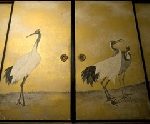
This shrine has been located on the mid-slope of Mt. Zozusan, since ancient times.
This shrine became Kingasho, a temple for the Tokugawa Shogunate to pray, in the Edo period (1603 – 1868). The folk in Edo competed to come this shrine, nicknamed Konpira-san. 10th Konkoin Yuzon (1739 – 1787), Betto, the chief Administrator of this shrine realized this trend. It was said that Yuzon learned the painting in Kyoto, by Ito Jakuchu (1716 – 1800), a Japanese painter, in his boyhood days.
He had an eye to identify the real thing that would become the pioneer in the days. 5 halls of Omote Shoin, reception hall, are decorated with a wall painting by Maruyama Okyo (1733 – 1795) a painter and the founder of Maruyama school of painting. The wall painting was made in the later years of Okyo in the Tenmei era (1781 – 1789) – the Kansei (1789 – 1804) era in the Edo period, which were highly evaluated in Paris, now.
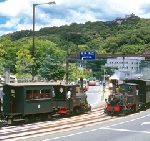
This train began in 1888 and is the first light railway in Japan. This train was a steam locomotive in the Meiji period (1868 – 1912), which became a diesel train. Soseki Natsume (1867 – 1916), a Japanese novelist, best known around the world for his novel, Botchan, had problems in Tokyo and moved to Matsuyama City in 1895, as a junior high school teacher, in the old education system.
– Later he wrote the novel Botchan based on his stay in Matsuyama at that time. In the novel Botchan, the Iyo Railway in the light rail days appeared as a ” Train like a matchbox”. A train of the same shape as the “Botchan train” of the light rail days was revived, in the Heisei period (1989 – 2019).
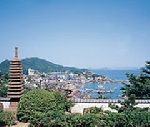
This temple was founded by Kobo Daishi Kukai (774 – 835), the founder of the Shingon sect. The wooden statue of Yakushi Nyorai, the Buddha of Healing is a Prefecture designated cultural property. Taishi-den, another worship hall of this temple has the view of the entire Tomoura port, where the envoys from abroad visited in the Edo period (1603 – 1868).
Philipp Franz von Seybold (1796 – 1866), German physician, botanist and traveler, who studied Japanese flora and fauna and introduced western medicine in Japan, climbed there and saw it. Seybold was the German physician of the Dutch East India Company in Nagasaki, who accompanied the Dutch trading house’s curator to Edo, Tokyo in 1826. He investigated the geography, climate, plants and astronomy of Japan, during those travels.
And this lead to the Seybold Case in 1828, when Seybold tried to take out of the country, state-banned maps of Japan.
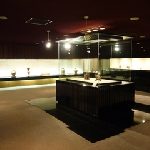
After molding and drying, Bizen ware, the ware that is said that has become Sueki, is baked without glaze, and completed with a method of setting works in the kiln, and firing the split pine wood to a point that it exceeds one thousand degrees. No one is the same Bizen ware.
At this museum, masterpieces are displayed along with the history of Bizen ware. This museum introduces the Bizen ware of Umiagari, Ko Bizen ware pulled up from a ship sunk in the Seto Inland Sea, which has the deep taste of porcelain surface, and Saishiki Bizen, color decorated Bizen ware in the Edo period (1603 – 1868). It conveys the breadth of the beauty of Bizen ware.

Chaushuyama Park overlooks the center of Bizen city and Katakami Bay. The scenery of Shinkoji Temple from the park is also wonderful. This temple has a history from the Nara period (710 – 794), which had a patronage by Okayama Domain during the Edo period (1603 – 1868).
The three-storied pagoda, with a height is 18.2m, was relocated from the ruined temple in Ushimado Setouchi City, in 1613. It’s eaves are strongly curved and become smaller in the upper stories. The pagoda has the special feature in the Muromachi Period (1366 – 1573).
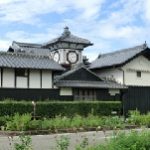
Ruins from the Yayoi period (the 4th BC – 3rd century) are scattered along the Aki River terraces in eastern Kochi Prefecture.
Soga Akae (born 623), a senior regent in the court during the Asuka period (550 -710), was exiled from the capital in 672 during the Jinshin War, a war of Imperial succession between Prince Oama and Prince Otomo, the son of Emperor Tenchi (626 – 671). The descendants of Soga Akae became the Aki Clan, a powerful, local family that owned Aki Gosengan (10,000 koku, a unit of volume of rice in Aki Province) in the Age of Provincial Wars in the 15th – 16th centuries, and were the most powerful clan in the eastern part of Tosa Province, Kochi.
Around 1887, during the Meiji period (1868 – 1912), Hatakenaka Genma (born 1861), a landowner in the area, created this Clock Tower. His father bought Genma a Hakaku Tokei, an octagonal-shaped clock, made in the USA, when Genma was 10 years old.
He repeated to disassemble and assemble the clock, and learned its mechanisms. Based on his understanding, he made every part of this clock by hand and completed this Clock Tower to inform the local people of the time of day.
Doing pragmatic things for others is the DNA of Aki Gosengan. You can watch it, too.
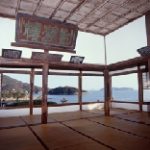
This temple, founded in the Heian period (794 – 1185), has a famous Kyakuden, reception hall, Taichoro, meaning a tide viewing hall, adjacent to the main hall. Taichoro was built during the Genroku era in the Edo period (1688 – 1704), as a Reception Hall for the Chosen Tsushinshi, Envoys from Korea for Peace Building and Cultural Exchanges between Korea and Japan from the 17th to 19th century.
The envoy praised that the prosperity of Osaka at that time was higher than that of Beijing, China, and that the view from Taichoro, was the most beautiful scenery in the region east of Korea. In 1748, a senior envoy, Hong Gye-hui (1703 – 1771) gave the name of Taichoro to this hall and his son, Hong Kyung-hae, left calligraphy writing at this hall.
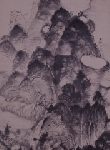
This museum close to Okayama Korakuen Garden, possesses many works in a wide range of genres, including Sesshu Toyo (1420 – 1506), a Zen monk and the master ink painter in Japan, Miyamoto Musashi (1584 – 1645), a Japanese swordsman, writer and painter, and Urakami Gyokudo (1745 – 1820), a Japanese musician, poet, and calligrapher, related to Okayama prefecture.
Gyokudo was a literary painter of the Edo period, and was named after the name of a famous Koto, Chinese harp from the Ming Dynasty (1368 – 1644).
After learning poetry and the seven-stringed Koto from an early age in his life, he became a lordless samurai at 50 years old and wandered about Provinces in Japan. In his later years, he lived in Kyoto, loved Sake, Japanese rice wine, and Koto.
He painted Sansuiga, Landscape painting, like the improvisation, and drew landscapes that he imagined.

Kurashiki was a Shogun demesne in the Edo period (1603 – 1868), where visiting cultures from overseas had come, since ancient times. It produced excellent human resources, like Kibi no makibi (695 – 775), a Japanese scholar and noble who played the role of connecting with the Chinese Continent in the Asuka period (550 -710), and Nara period (710 – 794).
Makibi worked on the construction of the nation based on the Ritsuryo system, a system of centralized government based on Ritsu, a criminal code and Ryo, an administrative code. He had the patronage from Emperor Shoumu (701 – 756), and Empress Komyo (701 – 760), the consort of Emperor Shoumu.
This park is a memorial to Makibi, who had learned and refined his insights beyond the difficult sea while on an envoy ship to the Tang Dynasty (618 – 907). The Memorial Hall, in the style of the Tang Dynasty, introduces Makibi, who invented Kata-kana, a writing system based on Japanese syllabary, and spread Igo, the board game of capturing territories, to Japan.

This museum is located at a famous spot, Katsurahama beach, between Ryuzu Cape and Ryuo Cape. This beach is bow-shaped and was mentioned as “the moon shadow to come out from the surface of the sea” in a poem.
The reason for this museum’s location is that Sakamoto Ryoma (1836 – 1867), a low-ranking samurai from the Tosa Domain became a lordless samurai by crossing the pass from the Tosa Domain. He influenced the Meiji Restoration, the establishment of the Empire of Japan, when he returned Tosa Province finally from this beach.
Nakahama Manjiro (1827 – 1898), was one of the first Japanese to visit the USA. He was an important translator. Kawada Shoryo (1824 – 1898), was a Japanese painter, who trained younger generations in Kochi. After Manjiro returning to Japan, Shoryo investigated Manjiro in Tosa Domain Kochi. Shoryo understood foreign affairs through his visual imagination.
Ryoma learned commerce by navigation strategy from Shoryo. Ryoma also understood strategy by overlapping it with this scene of the moon leading the tide and returning it.
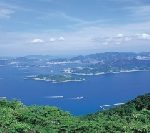
Mt. Fudekageyama (Height 311m) has the view of the beauty of the archipelago in the Seto Inland Sea. There are about 2000 cherry trees in the spring, hiking from summer to autumn, and the sea fog in the winter is exceptional.
This mountain has seen so many things. The voyage of the ship of an envoy to Tang Dynasty (618 – 907), and Kitamae-bune, cargo ships that sailed the Japan Sea during the Edo period (1603-1868). Chosen Tsushinshi, Envoys from Korea for Peace Building and Cultural Exchanges between Korea and Japan from the 17th to 19th century. Ryukyu Shisetsu, the mission from Ryukyu Domain to Edo. Periodic diplomatic visits to the Tokugawa Shogunate in Edo, and the group of curators of the Dutch trading house of the Dutch East India Company, that visited the Tokugawa Shogunate in the Edo period.
The mountain was named by Rai Sanyo (1781 – 1832), a Japanese Confucian scholar, historian and Imperialist who supported emperor-centered nationalism at the end of Tokugawa Shogunate period. Sanyo named it by overlapping the shape of the mountain shadow in the sea with a drawing brush. It was his wit.
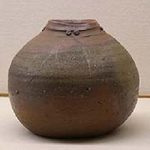
Bizen ware, the ware that is said that has become Sueki, was depressed by porcelain during the Edo period (1603 – 1868). It was the living national treasure Kaneshige Toyo (1896 – 1967), a potter, who gained popularity domestically and abroad and built Bizen’s prosperity once again.
Fujiwara Kei (1899 – 1983), a Japanese potter, learned from Toyo, started making Bizen ware as a 40-year-old. Fujiwara Kei was enthusiastic about literature and Haiku, Japanese seventeen-syllable poems, and wandered about to discover his life. He found something about Bizen ware inside himself, an existence to pursue an imposing and undeniable beauty.
And he was designated a living national treasure of potters. This memorial museum tries to introduce the imposing and undeniable beauty.
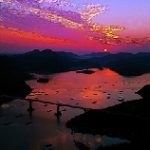
The far view from Katakami Ohashi Bridge is splendid. It is a steep and soft landscape, layered with the mountains and the sea, and looks down on Mt. Yudachi Ukeyama, where the Senkandaki, the ceremony that prays for rain. Kenmon Taisei, the system in the Japanese Medieval Ages by which governance was shared by the manorial system among ruling elites.
The courtier, the samurai and the shrine and temple, was established in the Muromachi Period (1366 – 1573). The beauty world of Karamono Shogon, maestoso things imported from China, as the standard of the beauty, was also established in the Muromachi Period.
The goods from the Song Dynasty (960 – 1279) and the Ming dynasty (1368 – 1644) were actually transported via the sea route overlooking this bridge, which connected Hakata, Fuokka, Kyushu region and Sakai, Osaka, Kinai region, provinces surrounding Kyoto and Nara.

This museum possesses the collection of the Date family, which ruled Uwajima Domaine from Date Hidemune (1591 – 1658), a feudal lord, the 1st lord of Uwajima Domain, to Date Munee (1830 – 1906), the 9th lord of Uwajima Domain. Uwajima Domain was started by Hidemune in 1614. Hidemune was the eldest son of Date Masamune (1567 – 1636), a Japanese feudal lord, the founder and the first lord of the Sendai Domain.
This museum introduces the beauty of the Date family style, which had been handed down from Masamune, through pieces like Tensho Makie, gold lacquer in the Tensho period (1573 – 1592). On that Makie, the state of blooming chrysanthemums was well drawn.
This museum also introduces the days of the end of the Edo period, with the Arrival of Matthew C. Perry (1794 – 1858), a Commodore of the United Sates Navy, who played a leading role in the opening of Japan.

This museum is on the riverbank leading to Katsurahama beach, which is surrounded by greenery and water. This building is rooted in the Tosa climate, using Tosa plaster on the wall and Tosa tile on the roof. It possesses the works of more than 400 artists, including Marc Chagall (1887 – 1985).
This museum possesses art works of Kawada Shoryo (1824 – 1898), such as Seiobo, an ancient Chinese goddess. He was a Japanese painter, who learned the Kanou school of painting in Kyoto and trained younger generations in Tosa Province Kochi.
Nakahama Manjiro (1827 – 1898), was one of the first Japanese to visit the USA. He was an important translator. After Manjiro returned to Japan, Shoryo investigated Manjiro in Tosa Domain Kochi. Shoryo understood foreign affairs through his visual imagination.
Sakamoto Ryoma (1836 – 1867), a low ranking samurai from Tosa Domain, who influenced the Meiji Restoration, the establishment of the Empire of Japan, learned commerce by navigation strategy from Shoryo.
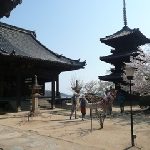
This area had been the place of a port for awaiting a favorable tide and wind since ancient times. Chosen Tsushinshi, (Envoys from Korea for Peace Building and Cultural Exchanges between Korea and Japan from the 17th to 19th century), including Kaito-ken-sakkanshi, Envoys from Korea that replied to a sovereign letter, visited the port during the Edo Period.
This temple was founded as a base for missionary work in the western part of Japan by the Nichiren (1222-1282) sect of Buddhism, in the period of the Northern and Southern Courts (1336 – 1392). It became the reception place and accommodation for Chosen Tsushinshi, along with Fukuzenji Temple at Tomo Hiroshima and Seikenji Temple at Okitsu Shizuoka in the Edo period (1603 – 1868).
The calligraphy written by the Communication Envoy and celadon porcelain vase from Korea, were handed down at this temple, showing that the scenery and appearance were excellent.

This museum tells the history of Tomonoura, which was a port for awaiting a favorable tide and wind, since ancient times. This port was described in Manyoshu, the 8th century anthology of Japanese poetry, and was an important military base to maintain the supremacy of the Ashikaga clan, which was established by the Muromachi Shogunate and ruled Japan during the medieval days of 1366 – 1573.
This port was a port of call of Kitamae-bune, cargo ships that sailed the Japanese Sea during the Edo period (1603-1868) in the early modern times. At that time, Chosen Tsushinshi, Envoys from Korea for Building Peace and Cultural Exchange between Korea and Japan from the 17th to 19th century, and Ryukyu Shisetsu, mission from the Ryukyu Domain to Edo, visited this port for diplomatic visits to the Tokugawa Shogunate in Edo.
Rai Sanyo (1781 – 1832), a Japanese Confucian scholar, historian and Imperialist who supported emperor-centered nationalism came here at the end of Tokugawa Shogunate period, to rely on Tomo’s merchants. Sanjo Sanetomi (1837 – 1891), Imperial court noble and grand minister of state in the Meiji Restoration, stopped over here in the exile of the Seven Nobles from Kyoto, in the end of the Edo period (1603 – 1868).
At that time, Sakamoto Ryoma (1836 – 1867), a low ranking samurai from Tosa Domain, who influenced the Meiji Restoration, the establishment of the Empire of Japan, negotiated here with the Kishu Wakayama Domain, when an Irohamaru sailboat was sunk by the boat of the Kishu Wakayama Domain.
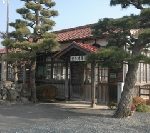
Kibi Province, Okayama was a key artery that connected the culture with the Chinese continent and the Korean peninsula since ancient times. The road of Tatara, an iron manufacturing method that uses iron sand from Izumo Province, Shimane to the Chugoku Mountains. The sand went by Takasebune, flatboat, down the Yoshii River from Chugoku Mountains to the south near the consumption area.
Today, the JR Inbi Line connects Tottori and Tsuyama City Okayma, instead of the Yoshii River. This station is the first station in Okayama, passing over the Monomi Pass, which is the prefectural border between Tottori and Okayama.
The scenery of Sotoyama, the village at the foot of the mountains, and the river from the station building on the hill, is the original scenery of Japan and is also the path of ancient history.

This museum appears in the Medieval style image, which is Irimoya Zukuri style building, the building with a hip-and-gable roof structure. It is at the site of the village headman’s residence and has roofing with copper-plates and stone walls. The center of the collection is the work of Tomioka Tessai (1836 – 1924), a Japanese painter and calligrapher, who was the last painter of the literary school in the End of the Edo period.
Tessai read many books and traveled to places far away. Buryo Togen-zu, his painting of earthly paradise, found by a fisherman from Buryo in China, after losing his way. That painting has the elegance of poetic unconventionality.
This museum possesses the western style painting of Kojima Trajiro (1881 – 1929), and Bizen ware of Kaneshige Toyo (1896 – 1967), who was a potter and a living national treasure.
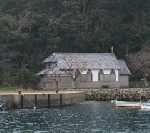
Former Gorin Church in Hisakajima Island of Goto Islands, is the second-oldest wooden church in Nagasaki prefecture (after National Treasure Ouratenshu-do, Oura church). It is located opposite the boat harbor at the fishing port.
This building has pantile roofing and a roof board with thin round bamboo. The arched ceiling in the sacred place is divided with eight partition boards. The gentle pointed arch is also provided at the top of the colonnade, to ensure continuity between the arched ceiling in the main corridor and the side corridor.
It is a precious style from the beginning of the Meiji period (1868 – 1912)

This museum opened in 2005, as a museum to convey the history of exchanges between Japan and Asia, which is located in the hilly area owned by Dazaifu Tenmangu Shrine in Dazaifu City Fukuoka Prefecture.
It exhibits a large number of masterpieces, such as Tosen, Nanbansenzu folding screen. (Nanbansenzu folding screen shows the beginning of Westernization in Japan by drawing the arrival of merchants and missionaries mainly from Portugal in the 16th century).
On the right screen, the black Nanbansen, the early European galleon ships, arrived Japan. Another screen depicts the party of Capitan Mor, a commander of Portuguese fleet, who went to Nabanji, a Christian church, built in Japan in the 16th century.
On the left screen, there is the white Tosen, a ship of the Ming dynasty (1368 – 1644), and the port town of China.
It is a very unique Nanbansenzu folding screen, with two drawings of departure.
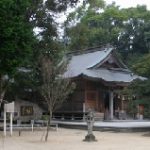
When Empress Jingu went to the peninsula for the conquest, she dedicated the sacred mirror, Kagami, to this shrine as a prayer for victory. This shrine name came from the mirror, which Murasaki Shikibu referred to, in the Tale of Genji, Japanese literature from the early part of the 11th century, as “The Miller, Kagami in Matsuura (of Kagami shrine)”.
From the top of Mt. Kagamiyama(284m), you can look out over Ikinoshima Island in the Genkai-nada Sea, which is located on the way to the Korean peninsula. When Empress Jingu returned to this place from the Korean peninsula, she had labor pains, and gave birth to Emperor Oujin safely with the clear water of this shrine. The emperor was regarded as the Yawatanokami, Hachiman deity (God of War).
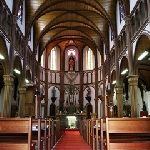
The Romanesque style Totenshu-do (Church) is in Kuroshima Sasebo. Christians escaped here from persecution during the Edo period (1603 – 1868).
A French priest established the National Treasure Ouratenshu-do, Oura church, in the end of the Edo period. Descendants of the underground Christians secretly visited them from Kuroshima.
Like Arita ware, the decoration on the floor of the church has not faded for over 100 years. Kuroshima has inherited this belief.
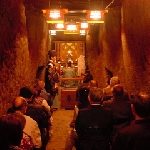
In the site of Miyajidake shrine are the Miyajidake Tombs. These are known as the “Underground Shosoin (Imperial Treasure House)” and were a megalithic burial mound from the end of the 6th century to the early 7th century.
The stone chamber, with a total length of 23m, consists of huge stones exceeding 5m in height and width. About 300 items were discovered, including harnesses, swords, green jade balls and glass plates.
National Treasure Gilt Bronze Tsubo Abumi and pot stirrups, exhibited at the Kyushu National Museum, are decorated with palmetto patterns and show their connection with the Silk Road. Horyuji Temple and Shosoin possess similar items, too.
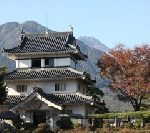
In 1633, Japanese Father Juliao Nakaura (1568 – 1633), a member of the Tensho Embassy to the Pope and the kings of Europe in 1582, was a martyr of Nagasaki. He was relegated to underground activities for 20 years by feudal Christian Japanese lords. As a result, Japanese Christians lost their professional religious leader.
In 1637, the Shimabara Rebellion (1637 – 1638) was in fact a riot against the coercion of Matsukura Katsuie (1597 – 1638), the 2nd feudal lord of the Shimabara domain, and his son, after the summer campaign of the siege of Osaka in 1615.
The shining, white 5-story castle tower of Shimabarajo Castle displays historical materials. Maria Kannon, statutes of the Virgin Mary disguised as a Buddhist Kannon: the Buddhist Goddess of Mercy, used by hidden Christians during the Edo period (1603 – 1868), are exhibited. Those statues were used to keep the light of faith even without a leader.
It represents the beauty from a single-minded person under irrational situations.
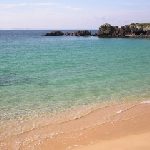
Iki Island was connected to Kyushu Island 10,000 years ago. After becoming an Island, Iki has had a history of relations with the Chinese continent and the Korean peninsula, including being occupied by the Mongolian Invasions of Japan (1274 and 1281), in the Kamakura period (1185 – 1333).
Nishikihama Promenade in the shallow beach on the east side of the airport, is the prosperous marine sports area. The promenade is the “Superb View Course at the Seaside”.
Nishikihama is a famous place where Empress Jingu — her husband was Emperor Chuai, and her son was Emperor Ojin — dried the clothing of Nishiki (Japanese brocade), when she went to the Korean peninsula in ancient times.
The name of the beach came from this legend of Nishiki clothing. Elegant wind blows on the shore, which wraps everything softly.
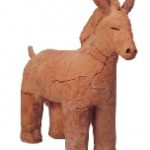
Tagawa City is located in the central part of Fukuoka prefecture. Tagawa has rapidly developed since the Meiji period (1868 – 1912), as a charcoal metropolitan of the Chikuho Coalfield. It is also the birthplace of the famous Tanko Bushi folk song.
The museum tells its history, which possesses the collection of Yamamoto Sakubei (1892 – 1984), a Japanese coal miner and painter.
The collection of Historical Coal Mine Paintings is listed at UNESCO Memory of the World Register. These paintings depicted not only the mining work, but also life of the people who worked in mining.
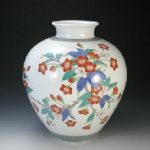
The first porcelain production in Japan started in 1616 in Arita Town Saga. Later, the 1st Sakaida Kakiemon (1615 – 1653), a Japanese potter succeeded in Akaetsuke, a porcelain decorated with a colorful painting overglaze, in traditional Chinese style, and established the Kakiemon style.
It features a bright, delicate, and pictorial composition with ample blank space on a soft, warm base like rice-washed water, called Nigoshide, a milky-white porcelain. You can enjoy well the Kakiemon style which, Meissen, the sister city of Arita, has always aimed for.

The museum possesses antique porcelain from various places in Kyushu Island, including Ko Karatsu ware, a traditional style of Japanese pottery produced in and around Karatsu, Saga.
It also possesses traditional and avant-garde modern works of Kyushu Island, and Ko Imari, traditional Chinese style porcelain shipped to Europe through the port of Imari Saga, which began exporting to Europe in the 17th century.
The origin of ceramics of Kyushu Island is Ko Karatsu. The bowl’s short lip exposes an unglazed surface. Its body, with semitransparent glaze, has a plant painted, like Hagi, a clover bush, reminiscent of the Autumn field.

Father Juliao Nakaura (1568 – 1633), a member of the Tensho Embassy to the Pope and the kings of Europe in 1582, was delegated by Christianized feudal Japanese lords. He said “I will be with those who give themselves into all possible persecutions due to their religion.” in a letter to an old friend in Rome in 1621. That letter is introduced at this museum.
The decree for purging missionaries was published before he returned to Japan in 1587, by Toyotomi Hideyoshi (1537 – 1598), the powerful feudal lord and Imperial Regent who unified Japan. The decree of prohibition on Christianity was published in 1614 by Tokugawa Ieyasu (1543 – 1616), the founder of the Tokugawa Shogunate.
Father Juliao Nakaura, who continued underground activities for 20 years, was martyred in Nagasaki, in 1633.

Aso Shrine which is located in Ichinomiyacho, Aso, enshrines the mountain god of Aso, the grandson of Emperor Jinmu, “Takeiwatatsunomikoto”. It was said that the mountain god of Aso kicked a part of Aso’s outer rim, which used to be an ancient lake, and flushed the water stored in the caldera lake to Kumamoto in the west. The God released the huge catfish from the caldera lake, spreading agriculture and cultivation to the people.
Along these transmissions, the approach to the Aso shrine does not go to the Worship Hall, but to Mt. Aso Takadake (1592m) and the Mt. Aso Nakadake Crater in the south. This shrine had major damage from the 2016 Kumamoto earthquake.
The restoration work has proceeded and will be restored in 2023. The Onda festival each July, which prays for a good harvest, continued even after the earthquake.
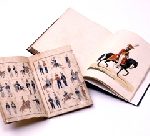
Takeo used to flourish as a postal town on Nagasaki Kaido, the main road that connected Sanyodo Road, from Nagasaki and had 25 postal towns, during the Edo period (1603 – 1868). At that time, Nagasaki was the only place that permitted diplomacy during the Tokugawa shogunate’s isolation policy. Nabeshima Shigeyoshi (1800 – 1863), the 28th feudal lord of Takeo, collected Dutch books on medicine, science, navigation, military studies, and encyclopedias in Nagasaki.
This museum is located near the Takeo Onsen Station. This museum possesses 128 Dutch books, glassware for physical and chemistry experiments, a celestial globe, a terrestrial globe, and a western style cannon, bronze mortar, and the first original cannon of Saga Domaine, which conveys the days.
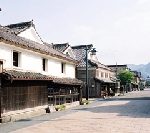
The Tara Kaido in the region on the Ariake Sea was the road leading to Nagasaki. The starting point was Shirota Post Town in Ureshino City, Saga Prefecture, which went up the Shiotagawa River from the Ariake Sea. Shirota Post Town is a free-spirited merchant town, unlike a castle town, with many white-walled town houses and warehouses that still remain to convey its history.
There is a village along the mountain, which has a group of historical sites that show where Christians fled to escape persecution. Nagasaki Kaido, the main road, which connected to Sanyodo Road from Nagasaki, had 25 post towns, where civilizations commuted, interweaving brightness and darkness.
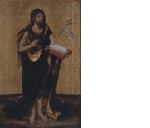
This museum next to Nagasaki Seaside Park, was opened in 2005, which is a 15-minute walk from Nagasaki Station, and overlooks Nagasaki Port from the rooftop. The concept is a “breathing museum”. The base collection is the collection of Suma Yakichiro (1892 – 1970), who was the appointed envoy extraordinary and minister plenipotentiary to Spain, and collected art works during the World War II.
This museum introduces Spanish art adding modern art such as Pablo Picasso (1881 – 1973), the Spanish artist who lived in France, Salvador Dali (1904 – 1989), a Spanish surrealist painter, and Art works associated with Nagasaki.
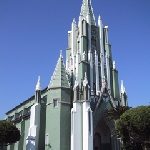
The best view in Hirado is the moss green outer wall, several white spires, and the cross of this church, along with the Buddhist temple.
This church facing the port of Hirado, commemorates the year of 1550, when Franciso de Xavier (1506 – 1552), co-founder of the Society of Jesus and the first Christian missionary to venture into Japan, landed from Kagoshima on a Portuguese merchant ship.
The rib vault ceiling with white stucco-finish, flying buttresses, and crimson carpets inside church, convey a new will to live.

This museum was built at the site of the lord’s residence of the Hirado Domain in the early Edo period, in the 17th century. Portions of the original stone walls remain. This museum possesses about 30,000 items, including armor from the Kamakura period (1185 – 1333), and later, furnishings of the feudal lord family. This museum also introduces the history of Nanban trade, Japanese trade with Spain and Portugal (1543 – 1641). Before Nagasaki, Dejima was built by an isolation policy of the Tokugawa Shogunate.
This museum introduces the hero of Asia, Tei Seiko, Zheng Chenggong (1624 – 1662), a Chinese Ming loyalist, who resisted the Qing conquest of China in the 17th century, and the hero of the most popular Japanese play, Kokusen-ya Kassen (the Battle of Coxinga), in 1715. He had a Japanese mother and was born in Hirado in 1642. He fought against the Netherlands and the Qing dynasty (1644 – 1912) for the restoration of the Ming dynasty (1368 – 1644).
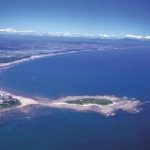
Aoshima, a small green island 1.5km around, is surrounded by wavy rocks called Oninosentakuita, a fantastic eroded rock formation that looks like a washboard. The rocks had been eroded by waves. They contained the regular alternating layers of sandstone and aqueous mudstone rock that accumulated on the sea floor during 24 to 2 million years ago. About 80% of Aoshima inhabiting plants are Biro, Livistona chinesnsis, belonging to the subtropical plant, palms. Aoshima Shrine is a guardian deity of this island, with a tropical atmosphere. This shrine enshrines Hikohodemi no mikoto, Yamasachihiko in the Japanese mythology of “Umisachihiko and Yamasachihiko”. Here, you can encounter the scene and the mythology, like Yamasachihiko‘s journey to the Palace of the Dragon King, where time passed very differently from the real world.
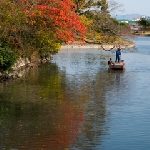
This sailing Boat takes you around the canal by Donko Bune, traditional Canal Boat. Along the canal ditch, the green of weeping willows shine. Namikura Red Brick Warehouse, and Namako-Kabe, the walls covered with square tiles jointed with raised plaster create relaxing shadows. You can also see closely Kumode-ami, traditional Net fishing. This boat ride lasts 70 minutes.
Tachibana Muneshige (1567 – 1643) , was a feudal lord, the 1st lord of the Yanagawa Domain. He was defeated in the Battle of Sekigahara in 1600 and his domain was confiscated. He became Ronin, a free-lance Samurai in Edo, by refusing the offer of finding a new lord. After returning to the former territory, he attended Tokugawa Iemitsu, the third shogun (1604 – 1651) at a tea ceremony.
He also participated in the Shimabara Rebellion (1637 – 1638). His honorable lifestyle mirrors the scene of the canal, not limited to one view.
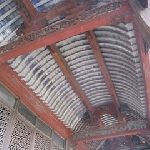
Saito Mokichi (1882 – 1953), a Japanese poet and a psychiatrist, visited this temple, called as Karadera, a Chinese temple. He stayed in Nagasaki as the professor of Nagasaki University Hospital, during three years and three months. He mentioned this temple, in the summer, in his poem, “In the calm after noon in the summer at Karadera in Nagasaki, miscellaneous thoughts came up, which could not stay in mind by the white blossom of crape myrtles in the garden.” This temple is fascinating in the afternoon in the summer, when there are fewer visitors.
Over the Sanmon, temple gate, this temple remains in the architectural style and the remnants of Ingen Ryuki Zenji (1592 – 1673), a poet, calligrapher and monk who found the Obaku sect of Zen in Japan. Those came from China.
You can experience the culture of the Obaku Buddhism sect, introduced to Japan from China during the Ming Dynasty (1368 – 1644). This greatly influenced Japanese early modern painting, including the Kanou School
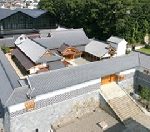
Sakamoto Ryoma (1836 – 1867), a low ranking samurai from Tosa Domain, who influenced the Meiji Restoration, the establishment of the Empire of Japan, was investigated in the murder of a British warship’s sailor, by a member of Kaientai, a trading, shipping, and private navy company, founded by Sakamoto Ryoma.
He negotiated with the officer of the Nagasaki magistrate’s office. This museum was built at the site of Nagasaki magistrate’s office, which was located in Tateyama Town along Nagasaki Kaido, main road, which connected the Sanyodo Road, from Nagasaki and had 25 post towns.
This museum introduces the restored Nagasaki magistrate’s office and Nagasakiha, the style of painting by painters based in Nagasaki, the only gateway abroad during the Edo period (1603 – 1868).
It includes the painting of the Obaku sect of the Zen sects in Buddhism, which was introduced to Japan from China during the Ming Dynasty (1368 – 1644), Kanga, Chinese style painting, and western style painting, such as Nanbanjin Raichozu folding screen, to show the beginning of Westernization in Japan by drawing the arrival of merchants and missionaries, mainly from Portugal, in the 16th century.
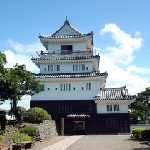
This castle facing the East China Sea was built by Matsuura Takashi (1646 – 1713), a feudal lord, the fifth lord of the Hirato Domain, in 1707. This castle was the only castle on a hill in the plains in Japan. Its basic layout was designed by Yamagaryu, Yamaga school military science.
The Matsuura clan, which was the feudal lord of this castle, used to be a marine force, with an active role in Matsuura Hizen province, Saga from the Heian period to the Sengoku period, the 9th -16th centuries.
National important cultural properties, like a sword with Head Ornaments, materials and armors of Matsuura Domain, materials of an underground Christian, and others. are exhibited inside the castle tower.

The Letterpress printing machine, which was brought here by the Tensho Embassy to the Pope and the kings of Europe in 1582, left Japan and moved to Macau, Philippines, after the decree of prohibition on Christianity was published in 1614 by Tokugawa Ieyasu (1543 – 1616), the founder of the Tokugawa Shogunate.
However, the books of Japanese studies were printed and published in Macau, which were used as references when Japanology became popular in 19th century Europe, 200 years later. This museum has a large collection of Banban culture, European Culture materials, and exhibits a reproduction of its letterpress printing machine.
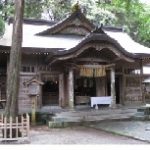
Takachiho is located in northern Miyazaki. It is said that there used to be Takachihonomiya, the Palace of Himuka Sandai, three generations of Ninigi, Hoori, and Ugayafukiaezu who were the ancestor of Emperor Jinmu.
Minamoto no Yoritomo (1147 – 1199), the 1st shogun of the Kamakura Shogunate sent Hatakeyama Shigetada (1164 – 1205) as his substitute to Takachiho Shrine and dedicated the treasure to this shrine in the Kamakura period. His dedicated a gift of Chichibu Sugi, Japanese cedar, and a pair of iron statues of shrine guardian dogs, Komainu (55cm tall).
These still remain on the site of this shrine. Iron statues are more difficult to cast the shape and details than bronze statues. Its high casting technology is really amazing.
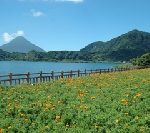
This lake is the largest caldera in Kyushu island, created by volcanic activity about 5,700 years ago. Large eels with a length of 1.8 m live in this lake. The Japanese eel has moved northward by the Kuroshio, the Japan Current from the deep sea of the Mariana Islands in the South Sea.
Coral reefs at the bottom of the South Sea over 200 million years ago moved north, due to crustal movements. They rose and became the Japanese Archipelago, and became Ubusuna, one’s birth place, for Japanese. It might be the lake that connects with the local Ubusunagami, a guardian deity of one’s birthplace.
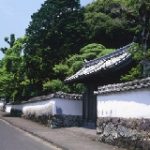
Kunikida Doppo (1871 – 1908) is a great writer of the Meiji period (1868 – 1912), the pioneer of naturalism, and the founder of Fujin Gaho – Japanese Lady’s Graphic. Doppo loved very much the castle town at the foot of Mt. Shiroyama in Saeki City. He described the path of the town at Azamukazarunoki – the diary of Kunikida Doppo, where he walked many times.
The path became The Path of History and Literature, with the residence of a high ranking samurai and a white earthen wall line from Otemachi, Saeki City along the foot of Mt. Shiroyama. The path is also an example of the beauty of modeling that overcomes Karagogoro – Chinese influence, and Western influence.

Four ships of the 16th envoy to Tang Dynasty (618 – 907), entered the cove of Fukuejima island as the last port of call in Japan in 804 and prepared to cross East China Sea for the Tang. Two ships succeed in crossing the sea, which Kobo Daishi Kukai (774 – 835): the founder of the Shingon sect, and Saicho, Dengyou Daishi (767 – 822): the founder of the Buddhist Tendai sect, were on board.
Tamaura in this island welcomed Kukai returned safely, where Shirobukurin, a white colored rim of Camellia japonica Tama-no-ura, was born by the mutation. It is said that beautiful camellia that were not discovered are still here.
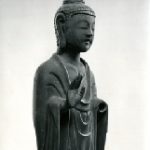
This temple is the oldest temple in Goto Islands which was the last port of call of Kentoshisen, an envoy ship that travelled to the Tang Dynasty (618 – 907) in Japan. In 806, Kukai returned from Tang and prayed here that the Esoteric Buddhism he had learned in Tang, could be useful for the nation and the people.
Two statues of Buddha designated as cultural property are enshrined in Goma-do, a hall to conduct goma (Fire Ritual). One of them is a wooden statue of Amida Nyorai, the principal image of Buddha in Pure Land, in the traditional Japanese-style, which is presumed to be the statue made in the end of Heian period (794 – 1185).
Another is a National Treasure, a bronze statue of Yakushi Nyorai, the Buddha of Healing, in the style of the Nothern Wei Dynasty (386 – 535), which is presumed to be a statue made in the Asuka period (550 -710). Currently, they are Hibutsu, hidden Buddhist images, ordinarily withheld from public view.

In 1637, the Shimabara Rebellion (1637 – 1638) occurred in Shimabara Nagasaki, after the martyrdom of the last religious leader, Father Juliao Nakaura (1568 – 1633). Nakaura was a member of the Tensho Embassy to the Pope and the kings of Europe in 1582, delegated by Christianised feudal Japanese lords.
It was the largest Christian Ikki, uprising, in Japanese history. Amakusa Shiro, who is said to be the leader, was born in Amakusa and was 16 years old at that time. It is unknown whether Shiro had already received a priesthood education, prior to leading the rebellion.
Overlooking Shimabara, on the other side of this coast and Shiro’s pure mind, you can see the crystal-clear waters, from the observatory, and the sunset over the horizon of the Amakusa-nada Sea.
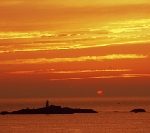
This promenade along the coast has an entrance in the huge Hyuga Sun Park in Mimitsu, Hyuga. The entire journey takes one hour. This vast scene is the scene of the beginning of Japan. The first emperor, Emperor Jinmu, gathered small boats in the bay and headed to the Kunisaki Peninsula, through the Bungo Channel, in a small group, in ancient times.
Sengoku Bune, a large junk boat, with capacity for 1,000 koku, a unit of volume of rice, arrived in Mimitsu, which was the commercial port of Takanabe Domain. Segoku Bune loaded with wood and headed to Kawachi Province from Mimitsu in the early modern time.
The sea road has continued since ancient times.
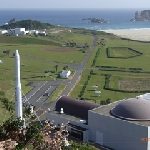
“The Road from the Paleolithic Age to the Space Age” -You can learn much about rockets, artificial satellites, astronauts, the surveys of the moon, and planetary exploration. The road to the new age of Space continues from here.
The rocket launch site facing the coastline is the most beautiful in the world. The Ryukyu Arc consists of 199 islands, which are located like flower frames about 1,260km south of Kyushu Island in the Japanese archipelago. There are high islands with forests and flat islands with fresh spring water. Tanegashima is a flat island, which is suitable for carrying and launching space rockets. In Tanegashima, the Shell Road, from ancient days, and the Guns Road, from the early modern age, overlap, which leads to the Space Road of contemporary times.

The museum collects and exhibits the works of local and international artists since the end of the 19th century.
Kuroda Seiki (1866 – 1924) a Japanese painter and a leader of the Western-style painting movement, was born in Kagoshima and went to France at the age of 17 to study law. While there, he become a painter. After returning to Japan, he introduced Japan to the light-colored Gaikou-ha, a Japanese painting style based on Plein Air, which adapted the changing light and subtle elements of impressionism.
He became known as the father of modern Japanese painting. Kuroda also created a concept drawing that consolidates the philosophy of Western Academism. He launched the Western-style painters group, Hakuba-kai, to hold exhibitions of their works, and developed the philosophy of beauty.
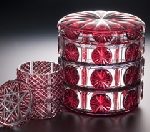
The 28th head of the Shimazu family, Shimazu Nariakira (1809-1858), felt a sense of crisis in the advancement of powerful Western countries to Asia, So, he built modern, Western-style factories, such as a reverberatory furnace, to make cannons and glass, at the place adjacent to the Shimazu family villa, Sengan-en Garden. It was there that Nariakira also made the first gas lamp in Japan.
He also developed Satsuma Kiriko, cut glass, as a foreign trade item. The feature of the cut glass is a special gradation to express the delicate Japanese sensibility, which originated from the ancient Silk Road and spread to the modern UK and China. Nariakira put a priority on the culture, as same as on the arms, for the future of Japan.
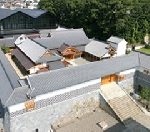
Nagasaki Bugyosho, The Japanese Government of Nagasaki was restored at Nagasaki Museum of History and Culture, which introduces historical materials such as Fumie, a loyalty test. Shoin, the drawing room or reception building and Oshirasu, a court of law, were restored there, too. Nagasaki Bugyosho was established in Tateyama Town Nagasaki, in 1592 during the Azuchi-Momoyama period (1573 – 1603). It had the responsibility for the administration, judiciary, diplomacy, trade, and military in general, as well as for the control of Christianity and smuggling.
Sakamoto Ryoma (1836 – 1867), a low-ranking samurai from Tosa Domain, who was influential to the Meiji Restoration, the establishment of the Empire of Japan, investigated the murder of a British warship sailor. Ryoma organized Kaientai, the association that managed trade and naval activity at the end of the Edo period, in 1865. A member of Kaientai was a suspect in the murder investigation. Ryoma negotiated well about the suspicion at this Nagasaki Bugyosho.
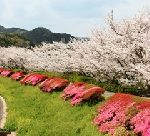
Kawaura Town has been a political and cultural center of Amakusa since old times. Amakusa Collezillo, a priest training school, was built in 1597, 42 years after Franciso de Xavier’s (1506 – 1552) arrival to Japan. He was the co-founder of the Society of Jesus and the first Christian missionary to venture into Japan, for 7 years.
29 types of Amakusa-hon, books printed by a western printing machine, were published by a Letterpress printing machine, which was brought here by the Tensho Embassy to the Pope and the kings of Europe in 1582. The Nanban culture, the European Culture, flourished here.
This park is presumed to be the site of Amakusa Collezio, and is a famous cherry blossom spot from the old days, where promenades and resting places are maintained.

The Kuma River is the largest river in Kumamoto prefecture. It flows from the Yatsushiro Plain to the Yatsushiro Sea, and has three major rapids in Japan. The 90 minute Kumagawa River Boat Ride from Hitoyoshi to Kyusen Cave, introduces the history of overcoming difficulties in water transportation, on site.
Sagara Yoritaka (1664 – 1703), the 3rd lord of Higo Hitoyoshi Domain, worked on this river development, in the Kanei era(1624~44)in the Edo period, and his uncle from Tanba Sasayama Hyogo, which had a history of developing the Hozugawa Gorge, worked on the Kuma River excavation project.
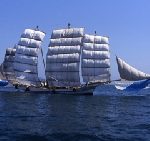
This sea, which spans the Kumamoto and Kagoshima prefectures, is surrounded by the Amakusa Islands. It is connected to the Ariake Sea in the north and the East China Sea in the south. In ancient times, on the Shiranuikai, it is said that a mysterious fire appeared on the dark sea. The legend states that a sailor would arrive at the port safely when he sailed the boat toward the fire.
You can experience the richness of the Yatsushiro Sea, by wind force, on a fishing boat at Ashikita Town, which has the Utaseami-amigyoho. It is a traditional fishing method, from the mid-19th century, which catches seafood by pulling fishing nets with wind force, which comes from stretching two or three sails parallel to the boat’s hull
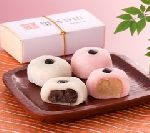
The founding of Miyazakijingo shrine is said to be the enshrined deity of Aso shrine, the grandson of Emperor Jinmu, “Takeiwatatsunomikoto”. The Tsuchimochi clan, the lord of a manor, in Hyuga Province, served and supported Usa Hachimangu Shrine in Oita.
They dedicated the shrine building during the Kamakura period in the 13th century. The Naito Family, Fudai daimyo, the hereditary feudal lord, who supported the Tokugawa shogunate, devoutly worshiped this shrine, during the Edo period in the 18th – 19th century.
Miyazaki Jingu’s specialty, Sanpaimochi rice cakes, originated from the rice cake that the villager in Mimitsunoura Hyuga Miyazaki made with mixed red beans, for good fortune. They were offered to Emperor Jinmu in Emperor Jinmu’s expedition to the east. Sanpaimochi are very popular sweets to invite good fortune.

Reimeikan is located on the site of Tsumarujo Castle in Kagoshima, which was the castle of the feudal lord, the Satsuma Shimazu clan. One of the excellent collections is the Bracelet of the Big Spiral Shell in the southern sea, Oninishi, which was made in the 3rd to 6th centuries from the end of the Yayoi period (the 4th BC – 3rd century) to the Tumulus period (the 3rd– 7th century).
It is presumed that it used to be an ornament for high ranking women in religious services. The unique pattern on the side is reminiscent of the tao-tie engraving of the Yin dynasty, in ancient China.
Its materials and patterns give us the image of transmitting along the East China Sea.
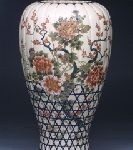
Ibusuki, Kagoshima has been opened to abroad geographically. This museum in Ibusuki exhibits 3,000 works of art, which shows the history of Satsuma Province Kagoshima as having been transformed by accepting various overseas cultures as the southern entrance to Japan.
This work is made in the late 19th century, between the last days of the Tokugawa shogunate and the Meiji Restoration, an event that sectored practical imperial rule of the Empire of Japan in 1868 under Emperor Meiji. It was made using the method called Nishikide, a white porcelain glaze, painted with opaque red, and transparent green, yellow, purple, and blue glaze.
This method is common to old Imari, Saga, the porcelains traded by the East India Company.
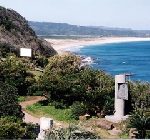
This cape is located at the southernmost point of the Tanegashima island, where the ship from Ming Dynasty (1368 – 1644) drifted ashore, 1543. It was said this ship sailed from Shangchuan, Guangdong, China, where Franciso de Xavier (1506 – 1552), co-founder of the Society of Jesus and the first Christian missionary to venture into Japan, died. At that time, the first Hinawajyu matchlock gun arrived in Japan from Portugal.
There is Teppouenraikikouhi, the monument of the first arrival of guns in Japan, and the observatory, which imitated Nanbansen, the early European galleon ships, and has the view of the Kuroshio, the Japan Current that opened the early modern time in Japan, with guns.
In 6 years after the first arrival of Hinawajyu in Japan, Oda Nobunaga (1534 – 1582), the legendary warlord and the military dictator, ordered 500 Hinawajyu for Kunitomo Village Omi Province, Shiga.
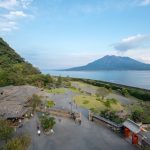
This garden was the villa of the Shimazu family, the lord of the Satsuma clan. It was built by Shimazu Mitsuhisa, the 19th family head of the Shimazu clan. Shimazu Nariakira (1809-1858), the 28th family head of the Shimazu clan loved greatly this garden. It attracted many people, such as Atsuhime, who became the lawful wife of Tokugawa Iesada (1824 – 1858), the 13th Shogun of Tokugawa Shogunate. This is the traditional garden of the Japanese feudal lords. It has a great view of Kagoshima (Kinko) Bay and the active volcano Sakurajima.
Shimazu Nariakira felt a sense of danger about Western countries entering Asia and constructed the first modern, Western-style factories in Japan.
In the garden, there is a stone lantern (Tsuru Toro) in said to resemble a crane taking flight, which was used for gas-lamp experiments and various other historical sites and give a sense of the Shimazu family’s history.
Nariakira and Abe Masahiro (1819 – 1857), the senior councilor of the Tokugawa Shogunate, took the leadership of modern civilization during the middle of the 19th century. Both of them also took care of breeding the changing morning glories, as mentioned enthusiastically in the Japanese gardening history of the Edo era. This garden has been growing those morning glories, too.
